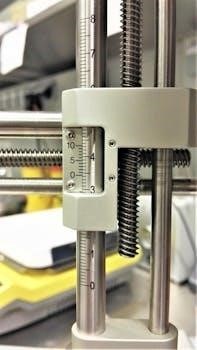Honeywell RTH6350D1000 Manual⁚ A Comprehensive Guide
This guide serves as a detailed resource for understanding the Honeywell RTH6350D1000 thermostat. It encompasses various aspects, from initial setup and programming to troubleshooting and maintenance. You’ll find information to effectively utilize this 5-2 day programmable thermostat and its features.
The Honeywell RTH6350D1000 is a popular 5-2 day programmable thermostat designed for convenient home temperature management. This model offers a balance between affordability and functionality, allowing users to set different weekday and weekend schedules. It’s a non-WiFi device, meaning control is limited to local interactions, but it simplifies energy savings through consistent scheduling. The thermostat is intended for 24V HVAC systems, making it a fit for many residential setups. Key features include a backlit display for easy viewing and straightforward programming options. This manual will guide you through the device’s features, installation, and usage. You’ll discover how to maximize comfort and efficiency with the RTH6350D1000. It is designed to be a user-friendly option for controlling home heating and cooling. This guide will provide all the necessary information to operate it. It is intended to be a comprehensive resource.
RTH6350D1000 Model Overview and Features
The Honeywell RTH6350D1000 thermostat stands out as a 5-2 day programmable model, designed to offer tailored temperature control for weekdays and weekends. Its primary feature is the ability to set separate schedules for the five weekdays and the two weekend days, promoting efficient energy use. The device is equipped with a backlit display, which allows for easy readability even in low-light conditions. This model operates on a 24V system, making it compatible with most standard HVAC systems. The RTH6350D1000 includes a ‘Hold’ function, which maintains a set temperature indefinitely until manually changed, overriding the programmed schedule. It uses simple button controls for setting the temperature and programming. It is a non-WiFi device, meaning you’ll interact with it directly. The thermostat is also designed with a quick reference card, which is accessible for basic operating instructions at a glance. Its interface and features aim for ease of use and effective temperature management, providing a user-friendly approach to home climate control.
Installation Guide for the RTH6350D1000
Before beginning the installation of your Honeywell RTH6350D1000, ensure that the power to your HVAC system is switched off. Begin by removing your old thermostat, leaving the wall plate and wires intact. Check if your old thermostat contains mercury; if so, follow the proper disposal guidelines as indicated in the manual. The RTH6350D1000 installation guide outlines the correct wiring configuration for your specific system type. The wall plate should be securely mounted onto the wall, ensuring it’s level. Next, connect the wires to the corresponding terminals on the new thermostat’s base, paying close attention to the labels and your system’s wiring schematic. After wiring, carefully attach the thermostat to the base. Once the thermostat is securely mounted, insert the batteries into their compartment. Finally, turn the power back on to your HVAC system, and verify that the thermostat is functioning correctly, displaying the room temperature. Refer to the full installation guide (33-00201EF) if you require further information or clarification. Ensure all steps are followed accurately to guarantee optimal performance.
Wiring Instructions and System Compatibility
The Honeywell RTH6350D1000 is designed for compatibility with standard 24V HVAC systems and is not recommended for 12VDC applications. Proper wiring is crucial for the thermostat’s operation. Before connecting any wires, it’s essential to identify your HVAC system type, whether it’s conventional or a heat pump. The wiring terminals are clearly labeled on the thermostat base, typically including R, W, Y, G, and C for conventional systems. For heat pump systems, additional terminals such as O or B might be used. When connecting wires, make sure each wire is securely attached to the correct terminal, following the wiring diagram specific to your system. If you are unsure about the wiring configuration, consult the installation guide (33-00201EF) or seek assistance from a qualified HVAC technician. Incorrect wiring can lead to thermostat malfunction or damage to your HVAC system. Always double-check your connections before powering on the system. For multi-stage heating or cooling systems, please refer to the manual for specific wiring instructions. Ensure the wires are not frayed or damaged before connecting.
Understanding 24V Compatibility
The Honeywell RTH6350D1000 thermostat operates on a 24VAC power supply, which is the standard for most residential heating and cooling systems. This 24V compatibility is essential for the thermostat to function correctly and interface with your HVAC equipment. It’s crucial to confirm that your existing system provides this voltage before installing the thermostat. Attempting to use the RTH6350D1000 with a system that does not provide 24VAC can result in malfunction or damage. This thermostat is not designed for systems using 12VDC or other voltage levels. The 24VAC power is typically provided by a transformer within your HVAC system. If you are unsure about your system’s voltage, consult your system’s documentation or contact a qualified HVAC professional. Proper voltage compatibility is not only about function, but also about safety. Incorrect voltage can cause damage to the thermostat, and potentially to your HVAC system. Therefore, confirming the compatibility with a 24VAC system is a key first step before proceeding with the installation process. This ensures the longevity and efficient operation of your new thermostat. Always prioritize safety and correct compatibility when working with electrical components.
Programming the RTH6350D1000 Thermostat
Programming the Honeywell RTH6350D1000 thermostat is designed to be user-friendly, allowing you to customize your heating and cooling schedules to match your lifestyle. This model offers a 5-2 day programmable feature, which means you can set different schedules for weekdays and weekends. To begin programming, you’ll typically use the buttons on the thermostat to navigate through the menu options. The thermostat allows you to set different temperature settings for various times of the day, such as morning, day, evening and night. This enables you to save energy when you’re away or sleeping; The initial step usually involves setting the current time and day, which is crucial for the thermostat to follow your schedule correctly. Then, you will proceed to set the specific temperatures and times for each period. The interface may involve using up and down arrow buttons to adjust temperatures and times. The ‘Hold’ feature is also an important aspect, which allows you to override the programmed schedule for a temporary period, maintaining a constant temperature until you manually change it. The program settings are saved to memory, ensuring your settings are retained even during power outages.
Setting 5-2 Day Programmable Schedules
The Honeywell RTH6350D1000 thermostat features a 5-2 day programmable schedule, which provides flexibility in managing your home’s temperature efficiently. This feature allows you to set separate heating and cooling schedules for weekdays (Monday through Friday) and weekends (Saturday and Sunday). To begin, you’ll access the programming menu, usually by pressing the “Program” or “Set” button. You will then be prompted to set the time and temperature for different periods of the day. Typically, the thermostat offers four time periods⁚ Wake, Leave, Return, and Sleep. For each of these periods, you can set the desired temperature for both heating and cooling modes. During the weekdays, for instance, you might set a higher temperature for the morning and evening when you are home, and a lower temperature for the daytime when you are away. The weekends can have different timings, reflecting your relaxed schedule. The thermostat will then automatically follow these set schedules, switching between the set temperatures at the times you have specified. This feature helps save energy and ensures your home is comfortable when you need it to be.
Adjusting Temperature Settings and Using Hold Feature
The Honeywell RTH6350D1000 thermostat allows for easy adjustment of temperature settings using the up and down arrow buttons. These buttons increase or decrease the desired temperature in increments, giving you precise control over your home’s climate. Simply press the up arrow to raise the temperature, or the down arrow to lower it. These changes apply only for the current period unless the hold feature is activated. The “Hold” feature is a crucial component, enabling you to override the programmed schedule temporarily. By pressing the “Hold” button after setting your desired temperature, the thermostat will maintain that temperature indefinitely, until you manually cancel the hold; This feature is particularly useful when your routine is disrupted, such as when you have guests or are home sick. It prevents the thermostat from automatically switching to the programmed temperature settings, which could be less comfortable. To return to the programmed schedule, you simply press the “Run” or “Cancel Hold” button, and the thermostat will resume its set schedule. Remember to always press the hold button after setting the desired temperature to maintain the setpoint.
User Manual and Quick Reference Guide
The Honeywell RTH6350D1000 thermostat comes with comprehensive documentation to aid users. This includes a detailed user manual and a convenient quick reference guide. The user manual is an extensive document providing in-depth information on all aspects of the thermostat. This includes installation instructions, programming details, troubleshooting tips, and maintenance procedures. It is the go-to resource for a complete understanding of the thermostat’s capabilities. This document is often available in PDF format online, making it easily accessible for users to download and consult. In contrast, the quick reference guide is a condensed version, offering a brief overview of the most essential functions. It’s designed for quick consultation, providing basic operating instructions at a glance. This guide is often a physical card included with the thermostat, allowing for immediate access without needing to search through the full manual. This card typically highlights common tasks like adjusting temperatures, setting schedules, and using the hold feature. Both the user manual and quick reference guide are crucial tools, catering to different user needs and ensuring easy and effective operation of your RTH6350D1000 thermostat.
Accessing the User Manual PDF
Obtaining the user manual for the Honeywell RTH6350D1000 thermostat in PDF format is a straightforward process, ensuring users have easy access to detailed information. The primary method is to visit the official Honeywell website, where the manual is typically hosted under the support section for the RTH6350D1000 model. This ensures you are downloading the most current and accurate version of the document. Alternatively, numerous third-party websites that specialize in manuals for various products may also host the PDF. However, it is crucial to exercise caution when downloading from unofficial sources and stick to trusted sites to avoid malware. Search engines can be used to locate these PDF files by entering the model number and the keywords “user manual pdf.” Once found, the PDF can be downloaded and saved on your computer or mobile device for convenient access. Having the manual in PDF allows for easy searching within the document, printing specific pages, and consulting information offline. This accessibility ensures that users can quickly find the answers they need when setting up, programming, or troubleshooting their RTH6350D1000 thermostat.
Using the Quick Reference Card
The Honeywell RTH6350D1000 thermostat comes with a quick reference card designed to provide users with an immediate overview of its basic functions. This card, often physically attached to the unit or found within the packaging, is a handy tool for quickly understanding essential operations without needing to consult the full user manual. Typically, the quick reference card will outline how to adjust the temperature, switch between heat and cool modes, and use the hold feature. It also often includes basic instructions on setting the 5-2 day programmable schedule. The card is designed for quick access to common tasks and might include visual cues or diagrams to aid understanding. To access the quick reference card, simply grasp and pull it from its designated location on the thermostat unit, which is usually near the battery compartment. This makes the card easily accessible when you need it. The information is usually brief but comprehensive enough for routine thermostat operation. This card is a valuable resource for everyday use and can help new users familiarize themselves with the thermostat without needing to delve into the more detailed instructions in the complete manual, proving to be a valuable tool;
Troubleshooting Common Issues
When using the Honeywell RTH6350D1000 thermostat, you might encounter some common issues. One frequent problem is the thermostat not responding to temperature adjustments, which can often be resolved by ensuring the batteries are fresh and properly installed. A blank display is another common issue, usually indicating dead or improperly installed batteries. If the thermostat is displaying an error message, consulting the user manual for specific error code explanations is crucial; this manual offers detailed guidance on understanding and addressing specific messages. Another problem is the thermostat not following the programmed schedule; this can often be fixed by verifying that the current day and time are set correctly. In cases where the heating or cooling system isn’t responding to the thermostat, double-check wiring connections and confirm that the system is powered on. If the thermostat is constantly cycling on and off, it could indicate a problem with the system or incorrect wiring. For issues with the system itself, it’s best to consult a qualified HVAC technician for assistance. If you are unsure about these steps, consulting the comprehensive user manual is always the best first approach to troubleshooting.
Maintenance and Battery Replacement
Maintaining your Honeywell RTH6350D1000 thermostat is essential for its optimal performance and longevity. Regular maintenance primarily involves checking and replacing the batteries. The thermostat typically uses two AA alkaline batteries, which should be replaced annually to prevent potential issues like display malfunctions or loss of programmed settings. A low battery indicator on the thermostat screen will notify you when replacement is needed, but it’s best to change them proactively as part of routine maintenance. To replace the batteries, gently remove the thermostat from its wall plate and locate the battery compartment, usually at the back. Remove the old batteries and install fresh ones, ensuring that you align the positive (+) and negative (-) terminals correctly. Once the batteries are replaced, reattach the thermostat to the wall plate. In addition to battery changes, it’s also a good idea to periodically clean the thermostat’s exterior with a soft, dry cloth to remove dust and dirt. Avoid using liquid cleaners, as they might damage the internal components. Regular maintenance ensures the thermostat’s reliable operation.
Where to Find Support and Additional Resources
For further assistance with your Honeywell RTH6350D1000 thermostat, numerous resources are available; The primary source of information is the official Honeywell website, which provides comprehensive support documentation, including user manuals and installation guides in PDF format. You can easily download these documents for quick reference. Additionally, the Honeywell support website often includes troubleshooting tips and FAQs, which can resolve common issues. If you need personalized assistance, consider contacting Honeywell’s customer service through their website or by phone. They can provide expert guidance and technical support for your specific situation. Online forums and communities related to home automation and thermostats can also be beneficial, where users share their experiences and offer advice. Retailers selling the RTH6350D1000 may also have their own customer support channels. Finally, remember to check for any warranty information provided with your purchase, as this will outline options for repair or replacement. Utilizing these resources ensures you have all the help needed for your thermostat.









